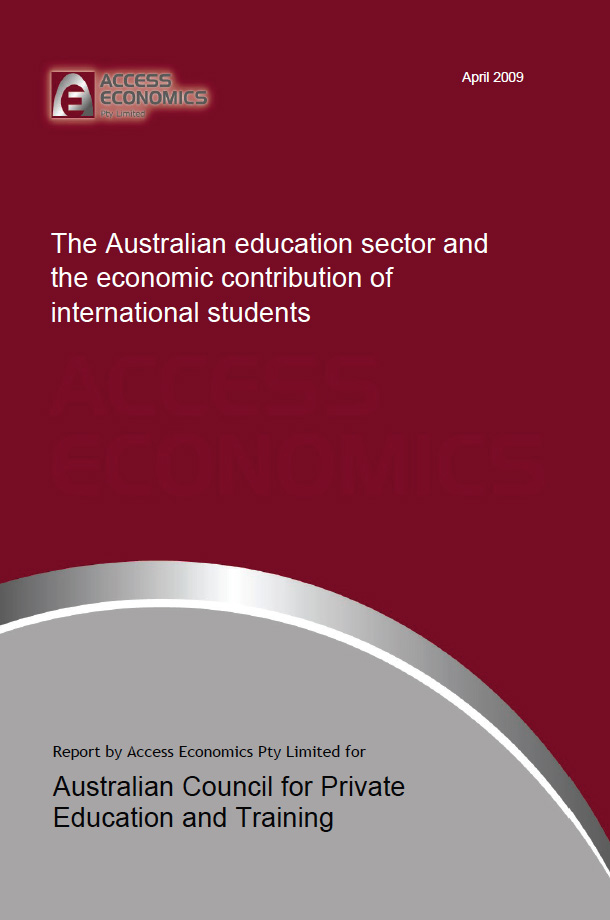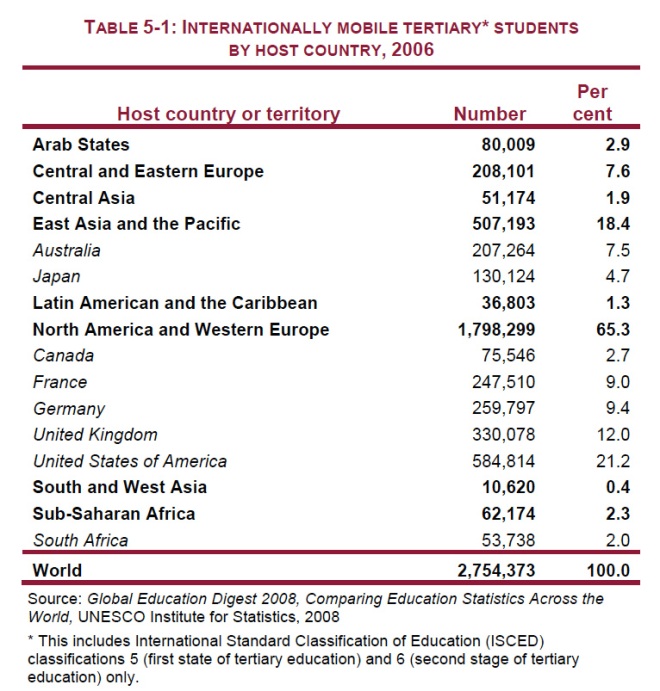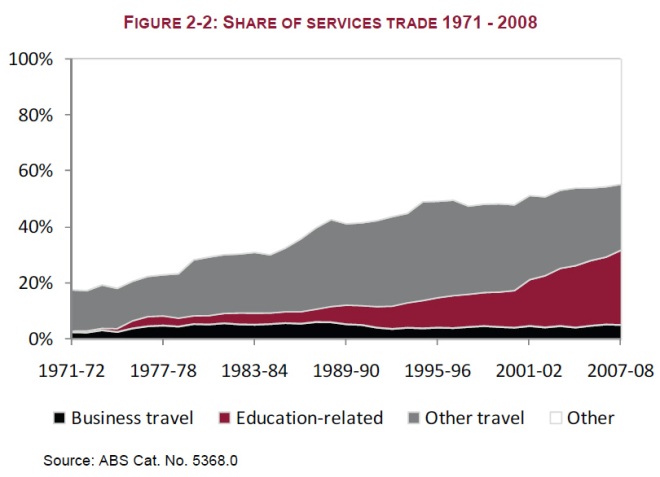 The latest contribution to assessing the “economic contribution” of international students to Australia’s economy was released last week. The informative report, titled The Australian Education Sector and the Economic Contribution of International Students, was prepared by Access Economics on behalf of the Australian Council for Private Education and Training (ACPET).
The latest contribution to assessing the “economic contribution” of international students to Australia’s economy was released last week. The informative report, titled The Australian Education Sector and the Economic Contribution of International Students, was prepared by Access Economics on behalf of the Australian Council for Private Education and Training (ACPET).
The executive summary of the 35 page report notes, amongst other things, that:
- Education services ranks as the third largest export category earner for the year 2007-08, behind coal and iron ore.
- Each international student (including their friend and family visitors) contributes an average of $28,921 in value added to the Australian economy and generates 0.29 in full-time equivalent (FTE) workers. Overall, this sees international students, and the associated visitation from friends and family contribute $12.6 billion in value-added.
- The share of education-related travel services has increased from around one per cent of total services exports in the early 1970’s to 27 per cent in 2007-08.
- International student expenditure in Australia contributes to employment in the Australian economy. It is estimated to have generated just over 122,000 FTE positions in the Australian economy in 2007-08, with 33,482 of these being in the education sector. Total student related expenditure (spending by students and visiting friends and relatives) generates a total of 126,240 FTE positions.
I’ll paste in a sample of tables and graphs from the report below:
Please keep in mind, as noted in our 24 June 2008 entry ‘Analysing Australia’s global higher ed export industry‘, that higher (tertiary) education is one of several contributing ‘education’ activities to producing export earnings:
- Higher Education
- English Language Intensive Courses for Overseas Students (ELICOS)
- Vocational Education and Training (VET)
- Schools
- Other Awards Sectors (e.g., “bridging courses and studies that do not lead to formal qualifications”)
The development of capacity to assess the economic impact of foreign students is part and parcel of the denationalization and commercialization process. Capacity to analyze and hence constitute this new services sector – a fast growing ‘industry’ in the views of many stakeholders – is strikingly variable. In my view Australia and New Zealand have gone the furthest down this path, and it is therefore worth understanding how the Australasians approach this issue from an analytical (economic impact assessment) perspective.
It is also important to understand which institutions are emerging as key knowledge brokers regarding the economic contribution of international students. As the New Zealand (see ‘Measuring the economic impact of ‘export education’: insights from New Zealand‘) and Australian cases suggest, private consulting firms made up of economists (some of whom used to work for federal/national governments) are key actors. There is, thus, a symbiotic relationship between the state and the private sector when it comes to analyzing the evolving nature of the services sector of the economy; one becoming increasingly associated with, in policy and analytical senses, education institutions and development agendas.
In addition, as in this case, we see an association of private sector providers contracting out to have this report developed. The ACPET is “the national industry association for independent providers of post-compulsory education and training, for Australian and international students”, including:
- Higher Education
- Vocational Education and Training
- English Language Courses
- Senior Secondary Studies
- Foundation Studies
The ACPET Mission is to:
Enhance quality, choice, innovation and diversity in Australian education and training for individual, national and global development. Work pro-actively and co-operatively with government, education and training providers, industry and community organisations, in order to ensure that vocational and higher education and training services provide choice and diversity, and well-targeted, appropriately delivered courses which are widely accessible and of high quality.
One proxy measure of ACPET’s make-up is its broad of directors, highlighting how non-university “post-compulsory education and training” actors are also becoming dependent upon foreign students in countries like Australia; a structural position that leads them to institutionalize and create an International Education Committee, which then coordinates the production of reports such as this via the expertise of Access Economics.
Given the dependency dynamic, reports such as these are both analytical devices, but also tools for lobbying. Reports such as The Australian Education Sector and the Economic Contribution of International Students are increasingly available for downloading in PDF format, which enables wide circulation via email. Traditional releases to media sources continue, as well: see, for example, ‘Learning boom amid the economic gloom‘ in The Australian.
As noted in the introduction to a recent guest entry (‘Measuring the economic impact of ‘export education’: insights from New Zealand‘), we are in the early stages of seeking a series of national viewpoints on how countries approach the export earnings issue. We would be happy to entertain proposals for guest entries on this issue, regardless of how well formed your own country’s capacity is to make sense of the data that is (and is not) available.
Kris Olds
Update: nanopolitan (‘Coal, iron ore, and education‘) makes the noteworthy point that “adjusted for population, Australia (21.7 million) hosts five times as many students as the USA (306.2 million)”. It might be worth adding that, according The Australian (‘Indian students boost the export economy‘, 2 April 2009) “Indian students now make up almost 18 per cent of Australia’s total foreign student population, the second largest group after China, which represents 23.5 per cent of the total foreign student body”.
Update 2: thanks to Brett for the links (see Comments) to two new news stories re. ‘Australian immigration launches probe on 20 colleges teaching international students for supply of fake education and work certificates necessary for the obtainment of permanent residency’.


